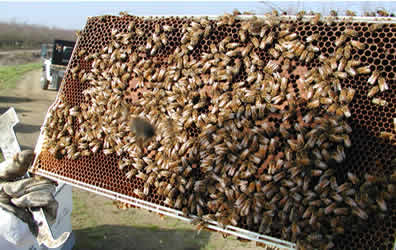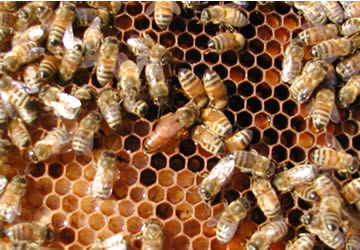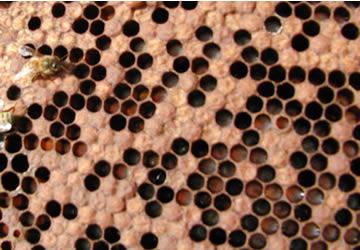

  |
|
The hive tool is made of hardened stainless steel and the end opposite the hook has a large tapered edge used for prying apart stuck boxes and lids. In addition to wax, bees make propolis which is a sticky substance made by the bees from and resin or sap collected from trees. They use it to plug holes in the hive, close cracks and glue things together. It's so sticky that at times, the top box can be lifted and the bottom box stuck to it with propolis and weighing 50 to 60 pounds comes up with it. The hive tool is an indispensable aid in the beeyard and always has it's place along side the other tools of the trade for working bees - the smoker and the beesuit. We'll talk about beesuits in the coming months. Presence of the queen bee is always a concern of the bees and the beekeeper. A hive without a queen cannot survive and a queenless hive will be dead in a matter of a few months. The bees in the hive are continuously aware of the queen's presence by a distinct odor (pheromone) emitted by the queen. Beekeepers must rely on visual inspection to determine the presence of the queen. At times, finding the queen can be problematic; ending in a frustrating exercise because the queen is shy and tends to hide in the hive or in a cluster of other bees. We got lucky in the above picture. Rather than hunting for the queen during hive inspection, it is much quicker to look for the indirect indications of a queen-right hive - the presence of brood and behavior of the worker bees. Brood, in it's various stages, is the reproductive process of the bees starting when the queen lays an egg and ending when the bee is hatched. Baby worker bees are born 21 days after the egg is laid by the queen in the bottom of a cell. The egg hatches into a larva in 3 days, the larva is fed by the young attendant bees and matures in the cell in another 6 days at which time the cell is sealed (capped) with beeswax by the attending bees. After 12 days in the sealed cell, the baby bee chews through the beeswax cap and crawls out - welcome to the world! Inspection for presence (or absence) of brood, in any of these three stages, is the best indication of a queen-right hive. Capped brood is visible in the above and below picture (right) - it's the brownish solid areas of the frame. Although very subtle, worker bees behave differently in queen-right hives compared to those in queenless hives. In a queen-right hive every bee has a job and they are "busy bees" working together in a coordinated and cohesive manner. Bees in a queenless hive don't exhibit this cohesive behavior to the same degree, they tend to run around on the frames more and don't cluster and mingle with other bees as readily. Experienced beekeepers develop a kind of sixth sense and can, at times, simply remove the lid and tell whether the hive is queen-right or not. |
  |
| A better picture of the queen bee, the one and only one in this queen-right hive. Worker bees clean and prepare the cells for her to lay the eggs. Her long tail allows her to deposit her egg at the bottom of the cell precisely in the middle. Some of the cells around her are partially filled with pollen which the bees have gathered and stored for later use. Sealed brood and a few lava (white) are visible in the other picture above. Eggs appear as tiny white spots at the bottom of the cell and are difficult to see, let alone, photograph. The best way to see them is to get the sunlight directly into the cell over your shoulder and look directly at the bottom of the cell. We'll discuss queens and queen rearing in April. |